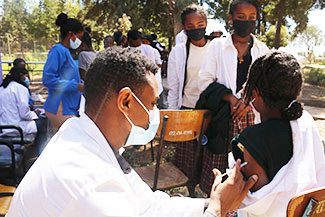WHO considers single-dose HPV vaccine schedule
July / August 2022 | Volume 21 Number 4
 Photo Courtesy of WHOHPV vaccination campaigns have seen slow uptake in many low- and middle-income countries. Moving to a one- or two-dose regimen could help reach the goal of 90% vaccination by 2030.
Photo Courtesy of WHOHPV vaccination campaigns have seen slow uptake in many low- and middle-income countries. Moving to a one- or two-dose regimen could help reach the goal of 90% vaccination by 2030.
The World Health Organization announced in April that it will consider
changing its regimen recommendation for the Human Papillomavirus (HPV) vaccine, which protects against cervical cancer, the fourth most common cancer in women.
The current policy advises two doses of the vaccine for 9- to 14-year-old girls, while girls 15 and older as well as the immunocompromised, beginning at age 9, should receive three doses. The Strategic Advisory Group of Experts (SAGE) on Immunization, which advises the WHO on global vaccine policies and strategies, recently evaluated evidence that single dose regimens are equally effective as two and three dose regimens.
One Costa Rica study conducted by researchers from the National Cancer Institute and other institutions found women who received either one or two doses of the vaccine had the same protection against HPV infections as a three-dose group.
Following its evaluation, SAGE suggested the WHO update its dose schedules for HPV as follows:
- one or two doses for the primary cohort ages 9 to 14
- one or two doses for young women ages 15 to 20
- two doses with a 6-month interval for women older than 21.
"Giving a single dose is less expensive and logistically easier compared with multiple doses," said Dr. Doug Lowy, Deputy Director of the National Cancer Institute. "Single dose vaccination will make it more feasible to vaccinate more women in low- and middle-income countries."
Further evidence is needed to show that the reduced dose schedule provides protection for immunocompromised individuals, according to SAGE. A high incidence of HPV-related cancers has been seen in those who are immunocompromised or living with HIV as well as in girls who face sexual abuse. SAGE recommended individuals in these categories be prioritized to receive two doses of HPV vaccine even if they don’t fall within the recommended age range.
“The HPV vaccine is highly effective for the prevention of HPV serotypes 16 & 18, which cause 70% of cervical cancer,” said Dr. Alejandro Cravioto, SAGE Chair.
In 2018, an estimated 570,000 women worldwide received a diagnosis of cervical cancer and about 311,000 women died from the disease, according to the WHO. Almost all cervical cancer cases are linked to infection with high-risk HPV, an extremely common virus transmitted through sexual contact. Most HPV infections resolve spontaneously and cause no symptoms, yet persistent infection can cause cancer.
Cervical cancer, known as the “silent killer,” is almost entirely preventable, according to the WHO. The vaccine provides effective primary prevention, and secondary prevention, in the form of screening for and treating precancerous lesions, will prevent most cervical cancer cases.
“These recommendations will enable more girls and women to be vaccinated, thus preventing them from having cervical cancer and all its consequences over the course of their lifetimes,” said Cravioto. SAGE also suggested that all countries urgently introduce the HPV vaccine for the primary cohort of 9 to 14-year-old girls and, when feasible and affordable, prioritize catching up missed girls and young women. Vaccination of boys and older cohorts of girls should be carefully managed while supplies of vaccines are constrained.
Lowy noted that "the vaccine has very high efficacy," but it only prevents new infections. "As most women are exposed to HPV soon after initiating sexual activity, it is important to vaccinate them before they become sexually active."
The evaluation was prompted by concerns about the slow introduction of HPV vaccine into immunization programs and overall low population coverage, especially in poorer countries. In 2020 global coverage with two doses was only 13%. Supply challenges, vaccine campaign snags, the relatively high cost of HPV vaccines, and difficulties delivering a two-dose regimen all contributed to low rates of use.
In response, the WHO launched the Cervical Cancer Elimination Initiative to address these challenges. The initiative aims to meet its 90-70-90 targets by 2030. These targets are: 90% of girls fully vaccinated against HPV by age 15 years; 70% of women screened by age 35 and again at 45; 90% of women identified with cervical disease receive treatment.
“This single-dose recommendation has the potential to take us faster to our goal of having 90% of girls vaccinated by the age of 15 by 2030,” said WHO Assistant Director-General Dr. Princess Nothemba (Nono) Simelela. She added the single-dose option helps facilitate catch-up campaigns for multiple age groups while allowing health care dollars to be redirected and spent on other priorities.
The WHO will conduct a stakeholder consultation before revising its position paper on HPV vaccination. A decision is expected in October.
More information
Updated August 11, 2022
To view Adobe PDF files,
download current, free accessible plug-ins from Adobe's website.
Related Global Health Research Topics